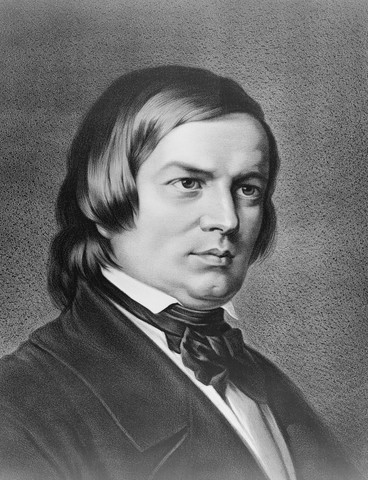Robert Schumann (1810-1856)
Born June 8, 1810 in Zwickau, Germany
Died July 29, 1856 in Endenich Germany
Symphony No. 2 in C major, Opus 61
Composed December 14, 1845 – October 19, 1846
First Performance: Leipzig Gewandhaus November 5, 1846 Felix Mendelssohn conductor
Instrumentation: 2 flutes, 2 oboes, 2 clarinets, bassoon, 2 horns, 2 trumpets, 3 trombones (alto,tenor,bass), timpani, and strings.
After an emotionally draining three year legal battle with Clara Wieck’s father for her hand in marriage, Schumann’s creativity erupted after their union in his Liederjahr (1840) in which he composed 168 songs. Before marriage Schumann made several incomplete attempts at writing for the orchestra including an incomplete G minor Symphony in 1832 (one movement was performed as his “first symphony”) and several unfinished piano concertos. At Clara’s urging he turned to the orchestra in 1841 and produced in January his first symphony – the Bb major “Spring symphony” Op 38 and later in the year another symphony which was heavily revised ten years later and published as his Symphony No. 4 in D Minor, op. 120. The C major Symphony of 1845-1846 although the third composed – or fifth if you count the 1832 symphony and the Overture, Scherzo and Finale, Op. 52 of 1841, which was described by the composer as a symphonette – has become known as his second symphony. It is the longest and most expansive of his four symphonies.
In 1845 Schumann was recovering from one of his frequent bouts of mental illness. In a letter to Mendelssohn he described a persistent ringing in his ears of a trumpet playing the pitch C. The key sequence of the movements – C major, C major, C minor, C major – is unusual and is perhaps related to his Tinnitus.
On April 2, 1849 he wrote to D. G. Otten, the music director in Hamburg: “I wrote my symphony in December 1845, and I sometimes fear my semi-invalid state can be divined from the music. I began to feel more myself when I wrote the last movement, and was certainly much better when I finished the whole work. All the same it reminds me of dark days.”
The movements are as follows:
I Sostenuto assai – Allegro ma non troppo
II Scherzo (Allegro vivace)
III Adagio espressivo
IV Allegro molto vivace
The work begins with a sustained chorale-like introductory section that simultaneously presents two contrasting themes. The brass intones a fanfare over a softly undulating melody in the strings. Both of these themes provide later material displaying Schumann fondness for uniting movements thematically. The middle of the introduction already modifies the opening material with the woodwinds introducing a dotted rhythm which previews the first theme.
Example 1. Chorale Opening
The brooding subsides as the first theme picks up the dotted rhythm from the middle of the introduction.
Example 2. Allegro, ma non troppo

The second theme is at once lyrical and energetic, rising in the first phrase and then falling in the second.
Example 3. Second theme

The movement ends with a coda which reiterates all the movement’s themes.
Schumann once again breaks tradition by following with a lively scherzo instead of a slow movement.
Example 4.

The scherzo includes the innovation from his first symphony of presenting not one but two contrasting trio sections.
Earlier in 1845 while Schumann was convalescing he studied counterpoint and the music of J.S. Bach. Immediately preceding the C major symphony he wrote his Six Fugues on the name Bach for organ, Op. 60 in which he indulged his interest in anagrams shown previously in the Carnaval Sphinxes and the Abegg Variations. The second trio not only has the character of a Bach fugue but Schumann skillfully weaves the old boy’s name into several phrases.
Example 5. Trio II

The Adagio espressivo third movement opens with a lovely arching theme introduced by the strings. As first pointed out by Brahms, this theme is a tribute to the theme of the Trio from Bach’s Musical Offering. The orchestration is in this movement is quite sensitive. The theme is initially presented by the violins then followed by solo oboe with bassoon in a passage mentioned in the Otten letter: “That my melancholy bassoon on the Adagio, written into that place with special affection, did not escape you gave me the greatest pleasure.”
Example 6. Adagio theme

Example 7. Bach – Musical Offering Trio

The Allegro molto vivace finale storms in with an exuberant sequence of rising scales which are featured in the development section. This is followed by the main theme whose repeated dotted recalls the main theme of the first movement.
Example 8. Finale main theme

An echo of the theme from the Adagio reappears as the exposition’s second theme.
Example 9. Adagio theme reprised

Example 10. Adagio theme inverted

The proceeds from the Fantasie in C Op. 17 for piano, written in the summer of 1836 while he was separated from Clara, were donated for the construction of a monument to Beethoven in Bonn. The close of the first movement reveals the source of its melodic material as the final song from Beethoven’s An die ferne Geliebte (“To my distant beloved”) which sets the words “take then these songs I have sung to you, beloved.”
Example 11. An die ferne Geliebte

Schumann’s fondness for this theme is revealed by the new theme that is introduced in the symphony’s coda.
Example 12. Coda

Schumann was fond of this device; he also introduced a new coda theme in his Bb and D minor symphonies. The length of the coda in this symphony rivals the length of the rest of the movement. Materials from the first movement including the fanfare reappear and bring the work to an upbeat close.
Resources
[amazon template=iframe image&asin=B0000029PC][amazon template=iframe image&asin=0486240134]

